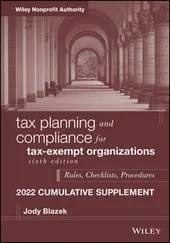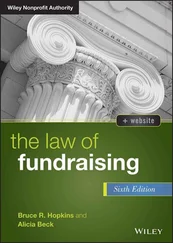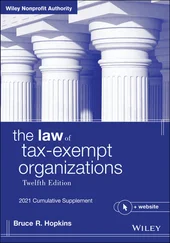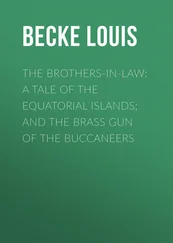Bruce R. Hopkins - The Law of Tax-Exempt Healthcare Organizations
Здесь есть возможность читать онлайн «Bruce R. Hopkins - The Law of Tax-Exempt Healthcare Organizations» — ознакомительный отрывок электронной книги совершенно бесплатно, а после прочтения отрывка купить полную версию. В некоторых случаях можно слушать аудио, скачать через торрент в формате fb2 и присутствует краткое содержание. Жанр: unrecognised, на английском языке. Описание произведения, (предисловие) а так же отзывы посетителей доступны на портале библиотеки ЛибКат.
- Название:The Law of Tax-Exempt Healthcare Organizations
- Автор:
- Жанр:
- Год:неизвестен
- ISBN:нет данных
- Рейтинг книги:4 / 5. Голосов: 1
-
Избранное:Добавить в избранное
- Отзывы:
-
Ваша оценка:
- 80
- 1
- 2
- 3
- 4
- 5
The Law of Tax-Exempt Healthcare Organizations: краткое содержание, описание и аннотация
Предлагаем к чтению аннотацию, описание, краткое содержание или предисловие (зависит от того, что написал сам автор книги «The Law of Tax-Exempt Healthcare Organizations»). Если вы не нашли необходимую информацию о книге — напишите в комментариях, мы постараемся отыскать её.
The Law of Tax-Exempt Healthcare Organizations — читать онлайн ознакомительный отрывок
Ниже представлен текст книги, разбитый по страницам. Система сохранения места последней прочитанной страницы, позволяет с удобством читать онлайн бесплатно книгу «The Law of Tax-Exempt Healthcare Organizations», без необходимости каждый раз заново искать на чём Вы остановились. Поставьте закладку, и сможете в любой момент перейти на страницу, на которой закончили чтение.
Интервал:
Закладка:
4 185 The use of one or more PARCs was announced in mid‐2015, in a memorandum from the Director, Exempt Organizations Division (TEGE‐04‐0715‐0018, July 17, 2015), where it was stated that a PARC consists of three General Schedule grade 14 managers, who will receive “appropriate training” and serve as a committee member for two years. A PARC is to review and recommend referrals for audit in an “impartial and unbiased manner.” The “inventory volume of political activities referrals” will determine the number of PARCs established and the time commitment required of the members of a PARC. It is not known whether the PACI is continuing by that name and thus whether use of PARCs is an element of an ongoing PACI.
5 186 TIGTA, “Review of the Processing of Referrals Alleging Impermissible Political Activity by Tax‐Exempt Organizations” (2019‐10‐006 (Oct. 4, 2018)).
6 186.1 See § 7.8, text accompanied by infra note 220.1.
7 186.2 Executive Order No. 13798.
8 186.3 This executive order in four instances frames its reach as being (as it must) within the law and, in addition, states that it is designed to “further compliance” with applicable statutory law. The prohibition, from an exemption standpoint, on political campaign activity by charitable organizations, including churches, sometimes referred to as the “Johnson Amendment,” is law. Therefore, from the standpoint of tax‐exempt churches and other religious entities and political campaign speech, it is hard to see what this executive order accomplishes for them. That would be the case if the order stopped there. But it does not.The order provides that the Department of the Treasury shall not take any adverse action against an individual or a religious organization engaging in speech about moral or political issues from a religious perspective, where speech of “similar character” has “not ordinarily been treated” as being in violation of the Johnson Amendment by the Treasury, which, of course, includes the IRS. That language effectively enshrines guidance issued by the IRS as to what constitutes violations of the Johnson Amendment, including the wide‐ranging Rev. Rul. 2007‐41 (see the text accompanied by infra note 210). It appears that, instead of a directive to the Treasury and the IRS to ease up on enforcement of the Johnson Amendment in the religious setting, as the order was originally advertised to be, it makes the granting of regulatory leeway to churches even tougher. That not ordinarily been treated standard is a high threshold indeed.Thus, a minister of a church can engage in political campaign speech from the pulpit as long as it does not fall within the types of speech found by the IRS to be political in character. Those interstices are going to be rather creative to craft.
9 220.1 REG‐134417‐13.
10 220.2 Fiscal Year 2016 Omnibus Appropriations Act, Pub. L. No. 114‐113, Division E § 127.
11 220.3 Fiscal Year 2017 Consolidated Appropriations Act, Pub. L. No. 115‐31, Division E § 126.
12 220.4 Fiscal Year 2018 Consolidated Appropriations Act, Pub. L. No. 115‐141, Division E § 125.
13 220.5 Consolidated Appropriations Act, 2019, Pub. L. No. 116‐3, Division D § 124.
14 220.6 Consolidated Appropriations Act, 2020, Pub. L. No. 116‐93, Division C § 122.
15 220.7 Consolidated Appropriations Act, 2021, Pub. L. No. 116‐260, Division E § 122.
CHAPTER EIGHT Hospitals
*§ 8.1 Federal Tax Law Definition of Hospital
§ 8.3 Public Hospitals
*§ 8.6 Pandemic Relief (New)
*§ 8.1 FEDERAL TAX LAW DEFINITION OF HOSPITAL
A federal definition conundrum occurred when Congress added additional statutory requirements for charitable hospitals to the Code. 16.1 These new requirements apply to charitable hospitals; however, for purposes of these requirements only, they only apply to organizations that operate a facility that is required by a state to be licensed, registered, or similarly recognized as a hospital. As a result, it is possible to encounter: (1) an acute care hospital subject to these rules that also qualifies as a public charity as a hospital; 16.2 (2) a rehabilitation center that is subject to these rules because it is licensed as a hospital under state law that elects to be classified as a service provider‐type public charity rather than as a hospital; 16.3 or (3) an outpatient physician clinic that qualifies as a hospital for public charity purposes, but is not subject to these rules because it is not required to be licensed as a hospital under state law. As the IRS has noted, it is important to understand which legal regime applies to these various definitions of a hospital under the circumstances at hand. 16.4
§ 8.3 PUBLIC HOSPITALS
p. 238. Delete last paragraph and insert at end of section:
Public hospitals generally do not pay federal income tax because their income is excluded from gross income owing to the exercise of an essential governmental function and accruing to a state or any political subdivision thereof. 44.1 For most of these hospitals, this is a sufficient rationale for not paying taxes. However, some hospitals in this category have also applied for and received recognition from the IRS as a charitable organization. In addition, hospitals that otherwise qualify as an affiliate of a governmental unit, 44.2 and thereby do not pay federal income tax, have also applied for and received recognition of their charitable status from the IRS.
There are a number of reasons for this. They typically include the ability to offer an annuity plan to employees as a fringe benefit; 44.3 a listing by the IRS in Publication 78, which can attract more charitable contributions; discounted postal rates from the U.S. Postal Service; and state and local sales and property tax exemption. Governmental hospitals that have been recognized as charitable organizations by the IRS and that also qualify as an affiliate of a governmental unit are described as “dual status” hospitals. 44.4 Municipal hospitals and municipal hospital districts are examples of hospital organizations that may be created by, controlled by, or are closely affiliated with the government but also have dual status. Even though they are recognized as charitable organizations, dual status hospitals generally do not have a Form 990 filing requirement. 44.5 In addition, they are not subject to the intermediate sanctions rules otherwise applicable to charitable organizations. 44.6
However, the IRS has determined that the requirements for charitable hospitals under the Affordable Care Act apply to government hospital organizations that are recognized as charitable organizations. 44.7 Based upon field examinations reported by the IRS in recent rulings, many of these public hospitals are no longer aware that they are also charitable organizations or that the Affordable Care Act obligations for charitable hospitals apply to them. In these rulings, hospitals falling into this predicament have agreed to have their charitable status revoked, finding the benefits of that determination no longer relevant, and their governmental public charity status sufficient.
A dual status entity may voluntarily terminate its charitable status. 44.8 A successful termination would secure the desired result that it is no longer subject to the ACA requirements for charitable hospitals. However, this voluntary termination would not remove compliance obligations (and potential penalties for failure to comply) for tax years prior to the effective date of termination.
*§ 8.6 PANDEMIC RELIEF (NEW)
The Coronavirus Aid, Relief, and Economic Security (CARES) Act was passed by Congress with bipartisan support and signed into law on March 27, 2020. 57 The $2.2 trillion relief package was designed to provide emergency assistance and healthcare response for individuals, families, and businesses affected by the 2020 coronavirus pandemic. The CARES Act is the largest economic stimulus package in U.S. history.
Читать дальшеИнтервал:
Закладка:
Похожие книги на «The Law of Tax-Exempt Healthcare Organizations»
Представляем Вашему вниманию похожие книги на «The Law of Tax-Exempt Healthcare Organizations» списком для выбора. Мы отобрали схожую по названию и смыслу литературу в надежде предоставить читателям больше вариантов отыскать новые, интересные, ещё непрочитанные произведения.
Обсуждение, отзывы о книге «The Law of Tax-Exempt Healthcare Organizations» и просто собственные мнения читателей. Оставьте ваши комментарии, напишите, что Вы думаете о произведении, его смысле или главных героях. Укажите что конкретно понравилось, а что нет, и почему Вы так считаете.












